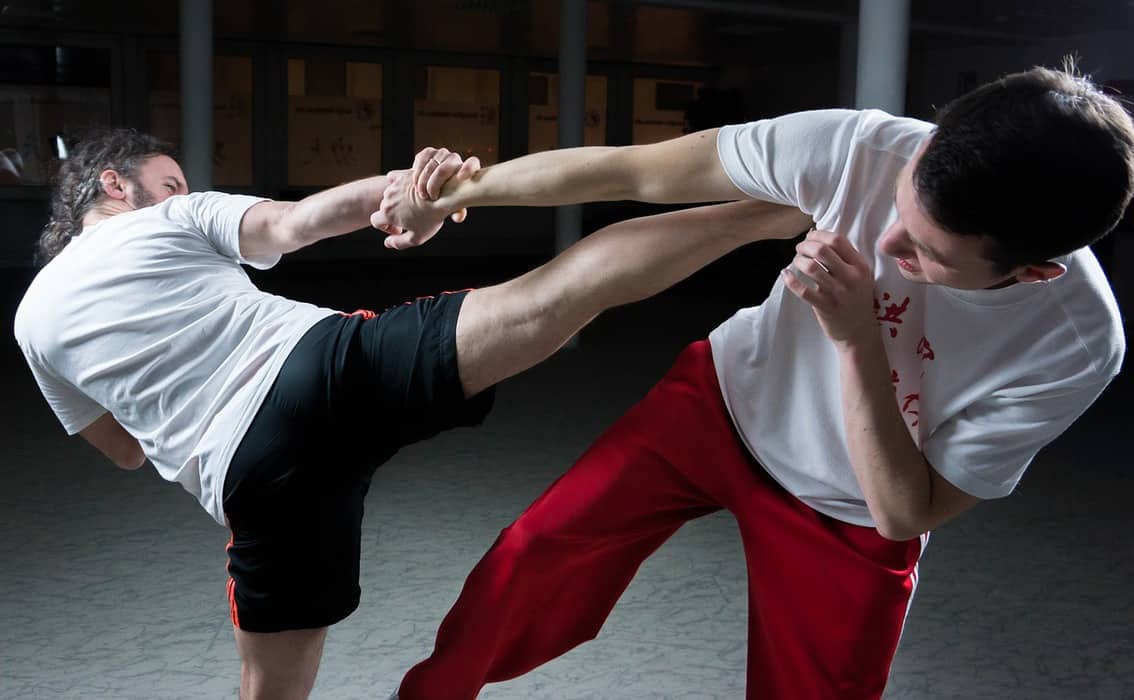
Almost everything can be done from the comfort of our homes these days… Our homes are quickly becoming the center of the world as technology brings everything to our fingertips. Each year feels like our world is becoming a smaller place to live in.
As much as the above may be true, this begs the question if this also applies to something as practical as learning self-defense at home? While you may want to learn in the privacy of your own home as a self-conscious person, at your own convenience amidst a busy lifestyle or at the cheapest price through all the YouTube videos, blogs or online courses around – can self-defense really be learned at home? and if so, what would be the easiest, quickest and most effective combinations to learn on your own?
Can You Learn Self-Defense At Home, Online Or Teach Yourself Some Combinations?
You can easily learn self-defense at home or online, however, keep in mind while you can learn the basics to help you get out of a tough situation by watching videos and reading online articles, you probably need a bit more training from an actual instructor, coupled with real-life simulations and sparring if you want to stand a better chance on the streets. This doesn’t mean that you can’t teach yourself using guided aides, that’s completely possible.
But don’t go watching a Jackie Chan movie and then think that you have the moves down!
You may need to actually sign up for a course.
Nevertheless, it’s perfectly normal to ask yourself this question since all beginners think this at some point when reading articles and watching videos that teach them self-defense moves.
We live in uncertain times…we live in dangerous times. You never know what’s going to happen the next time you pop out to the grocery store to pick up supplies, do you? Are you really safe? You might be deeply ensconced in living the All American Dream, but unfortunately, uncertainty surrounding your safety is part of that “dream” nowadays.
What can you do to protect yourself, without having to pay for expensive self-defense classes or spend hours in a gym or training room?
3 Quick & Easy Self-defense Training Moves To Learn By Yourself:
- Elbow strike.
- Groin kick.
- Hammer strike.
Without tackling yourself up in any formal Martial Arts class for self-defense, these are all very simple yet effective self-defense combinations that you can actually learn at home that will help you in a real-life situation. Once you have mastered these, you may feel so empowered that you seek out professional self-defense classes either in a physical class or online course. That’s when the “bug bites”! Self-defense is not just about protecting yourself and your loved ones, but also about keeping fit, being in control and quite frankly; feeling confidently powerful.
Differences Between Defense Classes and Learning at Home
The next question on your mind is probably about the effectiveness of learning at home and how this style of learning stacks up with learning in a class with a pro leading you and others to participate. Well, when it comes to the pros and cons, you can expect the following:
Should You Learn Self-defense Alone At Home?
| Pros of Learning Self-Defense at Home | Cons of Learning Self-Defense at Home |
| You get to learn at your own pace. | You may feel lost and unable to track progress. |
| You save money. | No other students to spar with. |
| There are no onlookers to feel embarrassed around. | No access to equipment and training aides. |
| You can train in your old track pants and a holey tee shirt. | Your form and technique may develop incorrectly with no one to keep rectifying and assist you. |
Should You Learn Self-defense In A Professional Class?
| Pros of Learning Self-Defense in a Class | Cons of Learning Self-Defense in a Class |
| Your form and technique will be correct from the start. | You might find it hard to keep up with other students. |
| You get to connect with other students who have the same interests. | You might not enjoy being in a group environment. |
| There are sparring partners readily available to practice with. | Learning alone without sparring partners might be preferable to you. |
| Your progress can be monitored and tracked. | You could end up with bruises and pain from sparring and hard workouts. |
| You can receive official grading and certificates as your progress. |
How To Learn These 3 Easy Self-Defense Moves At Home
Let’s not forget that we have already identified 3 pretty easy self-defense moves that you can and should learn at home now anyway. Once you have them down, you can consider whether or not a professional self-defense class is for you, or if you would prefer signing up for an online course. Here they are:
- Elbow strike.
The elbow strike is a powerful move that can help you take your attacker by surprise and get yourself to safety. The position you are standing in and where your attacker is approaching from will determine how you perform the elbow strike.
To perform an elbow strike from the front (when your attacker is approaching you head on) – here’s what to do:
- Lift your elbow up quickly to the height of your shoulder while keeping your arm firm and strong.
- Then, pivot on the foot of the same side of the lifted elbow.
- At the same time, rotate your hips to give the movement powerful momentum into the front of your elbow while striking.
To perform an elbow strike from the side or the back (when your attacker is approaching from next to you or behind you) – here’s what to do:
- Immediately draw strength into your core and stance hard into firm footing. This will ensure an effectively powerful strike.
- Bend your arm at the elbow, move your weight forwards and strike your elbow hard. This is a very effective move if you strike your elbow into the attacker’s chin, temple, jawline or neck.
This type of strike should take your attacker by surprise, making him/her loosen grip momentarily, so be ready to act immediately and run for safety.
- Groin kick.
The groin is where the self-defense magic happens. Make the groin your target and your attacker is going down. You have to do the move correctly though, or your attacker may just grab your foot, causing you to lose balance. And that’s not going to work in your favor at all. This particular move is best if your attacker is coming at you from the front…or if the attacker is approaching from the back or side and you have enough time to spin and face them head-on yourself. If you find your attacker is too close, use your knee. Here’s what to do:
- Take on a stable stance – you need good balance so be firm in your footing.
- Lift your leg (best to use the most dominant leg) and raise your knee quickly upwards.
- Extend the leg, push your hips forwards, lean your top half backward only slightly and then kick out powerfully in the direction of the attacker’s groin. You really want to strike hard and make sure you hit the groin with the area that’s between the ball of your foot and your lower shin area. That should do the trick.
This move should cause enough pain to make your attacker’s eyes water while experiencing a few short moments of paralysis (thanks to pain). This is when you need to make your escape. Don’t wait around to watch your handy work. Get moving to safety as quickly as possible as this pain won’t last or debilitate your attacker for very long.
- Hammer strike.
This is a move that requires your car keys. Perhaps if you are walking in an area you feel is unsafe, keep your car keys in your hand. Grip your keys in your dominant hand with your strong car key sticking out of your hand from the side, while holding a fist. Keep your arm stiff and strong – be ready to strike if needed. This one is going to hurt your attacker and that’s not going to make him/her very happy – be aware of this! Here’s what to do:
- While your key is held in your fist, imagine that your first is a hammer. The key must be protruding from the side of your hand as you are using the end of the key as a sharp, hard, weapon.
- When your attacker approaches, raise your hand and thrust down hard with the key pointing towards them. This is kind of a hacking motion – almost like you are holding a dagger or hammer. Keep thrusting and the moment you make contact and the attacker recoils, make your escape. Run fast, don’t look back. And of course, hang onto your weapon!
Best Home Study or Online Self-Defense Courses
A quick jump onto a Google search will tell you that the most popular or readily available online self-defense courses are as follows:
- Self Defense College – with courses from $349.
- My Self Defense Training – with courses from $59.
- Pro Self Defense Course – with courses from $89.99 [Highly Recommended]
What Equipment Do You Need to Learn Self-Defense at Home?

Okay, so if you do go the route of self-defense classes, what will you need? Will it end up costing you a fortune simply to study the art of self-defense from the confines of your living room or bedroom?
You won’t really need anything too complicated when learning self-defense at home. Most of the “weapons” and equipment could be every-day items around you. However, if you want to create your own makeshift dojo to get proper resistance when practicing, you might want to get a hanging bag or a free-standing bag that can act as your opponent.
If you want to practice blocks and counter-attacks, you might want to get a recoil punching bag. These are actually quite fun to work out with. Alternatively, if you don’t want to spend the money, you can just hang an old duffel bag from your ceiling or a tree.
Some training courses that are more involved might even offer you equipment and gear that you can buy as part of your training. The good news is that as you go along, you will learn about what you need and can get innovative about making makeshift alternatives.
Last Word
Learning self-defense at home is something that you can do if you have the willpower and focus. Really throw yourself into the process and try to connect with other people online who are doing the same course as you. You can share videos and tips and provide guidance and motivation – which is a great way to learn.
Finally, I’m sure just by trying to read and understand how to apply the 3 moves in this article has emphasized the possible complexity of trying to read and learn self-defense and has encouraged you to at least try to learn self-defense in a more practical or formal way by means of a class.
Good luck and enjoy!

